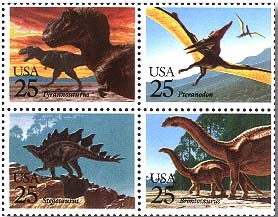Part 3 of 4 of my D-cember: Dino-cember! series
I heard on NPR’s TED Radio Hour in an offhand comment in the first segment of a November episode called Misconceptions, that the brontosaurus name is no more, and that kids today learn that it’s an apatosaurus (older name, same dinosaur).
Taken aback, I searched for the explanation… how could the brontosaurus name (meaning “thunder lizard”) be discarded in favor of apatosaurus (meaning “deceptive lizard”)??? Your average brontosaur—a median example, not the biggest—was roughly the weight of four bull elephants, and one individual’s thunderous stomp would have been about as “deceptive” as a gigantism-affected pachyderm herd stampeding x 50, i.e., not sneaky or deceptive at all.
In Dinosaurs: A Very Short Introduction, the author, British ornithologist and natural historian David Norman, described brontosaurus evidence: footprints of brontosaur herds that were found in Texas:
More convincing were some tracks observed by Bird at Davenport Ranch, also in Texas. Here he was able to log the tracks of 23 brontosaur-like sauropods walking in the same direction at the same time. This suggested very strongly that some dinosaurs moved around in herds. Herding or gregarious behaviour is impossible to deduce from skeletons, but tracks provide direct evidence.
… Some of the large sauropodomorph dinosaurs (the brontosaurs referred to above) may have weighed as much as 20-40 tonnes in life. These animals would have exerted enormous forces on the ground when they walked. On soft substrate, the pressure from the feet of such dinosaurs would have distorted the earth at a depth of a metre or more beneath the surface…
If herds of such enormous creatures trampled over areas, as they certainly did at Davenport Ranch, then they also had the capacity to greatly disturb the earth beneath – pounding it up and destroying its normal sedimentary structure. This relatively recently recognized phenomenon has been named ‘dinoturbation’.
… Great herds of multitonne dinosaurs moving across a landscape had the potential to utterly devastate the local ecology. We are aware that elephants today are capable of causing considerable damage to the African savannah because of the way that they can tear up and knock down mature trees. What might a herd of 40-tonne brontosaurs have done?
© David Norman, Chapter 7 in Dinosaurs: A Very Short Introduction
For more on this source, see its section of veryshortintroductions.com
So, yeah. Just imagine it, the extreme damage a herd of brontosaurs could do, “dinoturbation” of the landscape still obvious from the Jurassic Era, 208-144 million years ago (and it makes sense that brontosaurs, unarmored, gigantic prey animals without many defensive adaptations, would travel in herds for strength in numbers). What might a brontosaurus herd sound like?? Thunder, rolling thunder, louder than anything. Thunder lizard (brontosaurus) is clearly the right name.
Alas, the apatosaurus name won out, as noted by an NPR News piece just a year ago: Forget Extinct: The Brontosaurus Never Even Existed : NPR – All Things Considered (i.e. it didn’t exist because it’s apatosaurus and was acknowledged as such in 1903).
The American Heritage Science Dictionary has the most concise explanation of the brontosaurus naming controversy I’ve seen so far:
Take a little deception, add a little excitement, stir them with a century-long mistake, and you have the mystery of the brontosaurus. Specifically, you have the mystery of its name. For 100 years this 70-foot-long, 30-ton vegetarian giant had two names. This case of double identity began in 1877, when bones of a large dinosaur were discovered. The creature was dubbed apatosaurus, a name that meant “deceptive lizard” or “unreal lizard.” Two years later, bones of a larger dinosaur were found, and in all the excitement, scientists named it brontosaurus or “thunder lizard.” This name stuck until scientists decided it was all a mistake—the two sets of bones actually belonged to the same type of dinosaur. Since it is a rule in taxonomy that the first name given to a newly discovered organism is the one that must be used, scientists have had to use the term apatosaurus. But “thunder lizard” had found a lot of popular appeal, and many people still prefer to call the beast brontosaurus.
The American Heritage Science Dictionary, s.v. “brontosaurus,” accessed November 29, 2013
According to the brontosaurus information at the American Museum of Natural History, when paleontologist Elmer Riggs (Field Museum of Natural History, Chicago) published his study in 1903 showing the apatosaurus found was actually a juvenile example of the genus, not separate from brontosaurus, it technically ended the matter, “officially” the apatosaurus name took precedent from 1903 onwards.
But there had to be more to it. I still learned about “thunder lizards” in elementary school. Amidst the late ’80s-early ’90s “dino-mania” brontosaurs were widely seen (and labeled brontosaurus), so when and how did apatosaurus displace the brontosaurus name?
Stephen Jay Gould provides the best explanation of how the hell this happened: in his humorous essay “Bully for Brontosaurus” (one essay in the book Bully for Brontosaurus, which mostly consists of his essays on non-dinosaur natural history subjects) he explores taxonomy and the rules of the International Code of Zoological Nomenclature (ICZN), and explains that the apatosaurus name gained currency as an unexpected side-effect of the aforementioned dino-mania, mostly following all the whining over the 1989 USPS-special release of dinosaur stamps that labeled the brontosaurus as brontosaurus, like so:

These postage stamps were great; I was more inclined to mail letters when they could be stegosaur-stamped letters.
But the Postal Service got a mass of Comic Book Guy-type complaint letters demanding retraction of the brontosaurus name in favor of the apatosaurus name, and the media who had covered the release of the dino stamps since it was one of the first times USPS issued special stamps (unveiled at Disney World the year me/my family were there), got similar complaint letters. Soon, apatosaurus was widely known as the “correct” and “scientific” name.
In “Bully for Brontosaurus,” Gould explains:
I hate to be a shill for the Post Office, but I think that they made the right decision this time. Responding to the great Apatosaurus flap, Postal Bulletin Number 21744 proclaimed:
“Although now recognized by the scientific community as Apatosaurus, the name Brontosaurus was used for the stamp because it is more familiar to the general population. Similarly, the term “dinosaur” has been used generically to describe all the animals, even though the Pteranodon was a flying reptile.”
Touché and right on; no one bitched about Pteranodon, and that’s a real error.
The Post Office has been more right than the complainers, for Uncle Sam has worked in the spirit of the plenary powers rule. Names fixed in popular usage may be validated even if older designations have technical priority. But now…Oh Lord, why didn’t I see it before! Now I suddenly grasp the secret thread behind this overt debate! It’s a plot, a dastardly plot sponsored by the apatophiles–that covert society long dedicated to gaining support for Marsh’s original name against a potential appeal to the plenary powers. They never had a prayer before. Whatever noise they made, whatever assassinations they attempted, they could never get anyone to pay attention, never disturb the tranquillity and general acceptance of Brontosaurus. But now that the Post Office has officially adopted Brontosaurus, they have found their opening. Now enough people know about Apatosaurus for the first time. Now an appeal to the plenary powers would not lead to the validation of Brontosaurus, for Apatosaurus has gained precious currency. They have won; we brontophiles have been defeated.
© 1991, W. W. Norton & Co. and Stephen Jay Gould
essay viewable on Google Books: Bully for Brontosaurus
According to the ICZN Code, the first designated name for the species reigns, but the Zoological Congress of 1913 in Monaco added the plenary powers rule, an appeal process whereby applications to “suppress” the oldest name, if the current name is better and more well-known, could be reviewed. Gould describes the 1913 adoption of the plenary powers rule as a response to what I’d call griefers (a term from the world of massively multiplayer online games—MMOs—meaning someone whose primary means of enjoyment is the intentional griefing, verb: present participle, of other players, the ruining of others’ fun).

Some were using the ICZN oldest-name-gets-priority-rule just to derive pleasure from the panic and discomfort wreaked on the Zoological Congress when a well-established name was apt to get toppled; Gould describes an attempt to replace the name boa constrictor with an unknown obscurity that was ultimately suppressed using the plenary powers rule.
The plenary powers rule seemed to set the table for brontophiles to appeal the apatosaurus name. After all, the brontosaurus was everywhere, probably second only to the T. Rex in cultural ubiquity, commonly seen in comic books, comic strips (Alley Oop), cartoon shows and movies, The Flintstones, even as the mascot and logo of Sinclair Oil, and in U.S.-written animated shows, it was akin to visual shorthand for “Jurassic Era” or “dinosaur.” The brontosaurus is the dinosaur, what people picture when the word “dinosaur” is mentioned.
As dino-mania really took hold, Was (not was) had a big hit in 1987 (UK) and 1989 (US) with “Walk the Dinosaur,” which featured a dance in the music video, “the dinosaur,” done with forward motions of the hand/wrist to mimic a brontosaur’s neck, the most recognizable neck of all Dinosauria.
An aside: though “Walk the Dinosaur” became a dance craze song

I think the brontosaurus sticks in the popular imagination because it is such a huge, ridiculous animal, straining our ideas about the laws of physics and biology. Its short, stubby legs relative to its massive body brings to mind a cross between a dino-dachshund and Godzilla. Its feet look like elephant feet, big, padded oval-shaped feet with three or four front-facing, prominent toe-nails that looked a lot like this. Its absurdly-long neck shouldn’t even be biologically possible; getting consistent bloodflow up the neck to the brain and down to the tail—a 70-feet-long circulatory system—would have required

an incredible, 500-liter, mega-efficient, four-chambered bird-type heart, avian-esque but on a massive, big, big scale that is hard to fathom. With a reptilian circulatory system it really would be impossible.
Such an outlandish creature is hard to forget. Its image has real staying power. And it provides us a reminder of how beautiful and weird the natural world can be, how it tends to zigzag while our expectations go straight.
As for the brontosaurus name, it wouldn’t win an appeal to the plenary powers since the postage stamp kerfuffle (though it totally would have won such an appeal in 1965, 1975, even 1985) but we can still use the name. “Brontosaurus” (thunder lizard) is the more appropriate name and, as a slightly newer (1879) synonym, shouldn’t be seen as incorrect, no matter what they say. The best thing we brontophiles can do is keep the name in circulation on the internet, refer to brontosaurus in posts and comments whenever possible (and whenever impossible is fun too). Keep saying “brontosaurus” to keep it alive: brontosaurus, brontosaurus, brontosaurus.
A haiku I wrote, an ode to retaining the beautiful brontosaurus name:
oh great brontosaur
noble herbivore, thunder
feet ain’t “deceptive”
Nick
For more on the brontosaurus naming controversy, check out:
What Happened to the Brontosaurus? – The Museum of Unnatural Mystery (all content by Lee Krystek) – highly recommended for its comprehensive coverage and informative YouTube video
Google Books: Bully for Brontosaurus by Stephen Jay Gould
Forget Extinct: The Brontosaurus Never Even Existed : NPR – All Things Considered
For the other dinosaur-posts in my D-cember: Dino-cember! series, go to:
Part 2: Tananim Gedolim: “great reptiles,” the dinosaurs in the Torah (somewhat controversial)
Part 1: The Griffin Was Based On A Real Creature! (#1 most-visited page on nickscrusade.org, by far)
